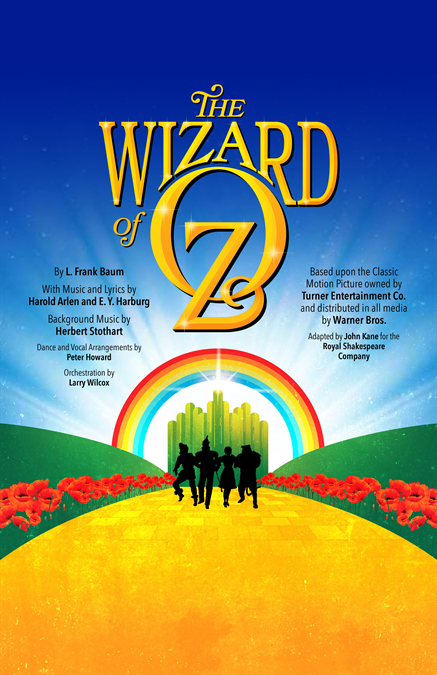This year, or what’s left of it, marks the 80th anniversary of one of the greatest films ever made, even more so when you consider how difficult it was to pull off, as it went through ten screenwriters and five directors, put its cast and crew through difficult working conditions, caused several cast injuries, and left Judy Garland’s brain scrambled. But the proof is in the pudding, and what they got was a cinematic triumph…well it actually took years of re-releases to turn a profit, as well as annual television airings that were revered as holidays. And why not, as it’s a timeless story that everyone can relate to, not to mention the gay appeal, as homosexual men are deemed “Friends of Dorothy.” Perhaps it’s because of the great musical numbers, as well as a story about two women fighting over a great pair of shoes. You know what I’m talking about. So naturally it’s perfect for the stage. Your next musical could be…The Wizard of Oz.

Authors: While there are plenty of stage musicals based on The Wizard of Oz, I’m focusing on the two based on the film. Both have music and lyrics by Harold Arlen and E. Y. “Yip” Harburg, and background music by Herbert Stothart. The first adaptation, from 1942, was adapted by Frank Gabrielson from L. Frank Baum’s novel The Wonderful Wizard of Oz and the second, from 1987, was adapted by John Kane from the novel as well as the film.
History: The 1939 film inspired a 1942 adaptation for the St. Louis Municipal Opera Theatre (the Muny), and a 1987 adaptation, much closer to the film, first produced in London by the Royal Shakespeare Company. Neither of these versions ever played on Broadway or Off-Broadway There was also a West End version in 2011 with additional music by Andrew Lloyd Webber and lyrics by Tim Rice, however its licensing rights are not yet available.
Synopsis: You probably know the story—Dorothy wants to get out of Kansas; a tornado takes her inside her house, which and drops her house on the Wicked Witch of the East; the Good Witch of the North sends Dorothy to the Wizard of Oz with the Wicked Witch’s ruby slippers; Dorothy meets the Scarecrow, who wants a brain, the Tin Man, who wants a heart, and the Cowardly Lion, who wants courage; the Wizard sends them to kill the Wicked Witch of the West, which they do; the Scarecrow, Tin Man and Cowardly Lion find they had what they wanted all along and Dorothy goes back home. The 1987 version is pretty much the same as the film, with some minor additions (Glinda doubles for Aunt Em, also the Jitterbugs sequence that was cut from the film is added back and the last scene reveals what happened to Miss Gulch). The 1942 version makes quite a few changes—there’s no Toto or Miss Gulch, the witch is not melted with water but instead done in by a shrinking charm and the Wizard takes Dorothy home in a spaceship (yes, really).
Cast Size: The 1942 version requires at least seven male, six female and seven of any gender. The 1987 version requires at least eight male, six female, and an ensemble with at least six of any gender, plus a cute little dog (unless you use an actor instead).
My Personal Take: Being based on a classic film musical brings expectations, and both versions pretty much deliver. The 1987 version does contain the classic lines and music, but does add enough new dialogue to make it worth attending, as well as clarifying a few points that the film didn’t make, such as wrapping up the Miss Gulch storyline. As for the 1942 version, well its deviations are interesting, and it does add a new song, “Evening Star,” that’s pleasant to hear, however the first two scenes of Act II go on a bit long and it adds jokes that aren’t really necessary. Still this is a very enjoyable musical with a timeless story and clever score, and while it may not be the greatest stage adaptation of a film musical it has justified its theatrical existence. It’s well worth a trip down the yellow brick road.
Put On This Musical If: You want to do a surefire classic that’s family friendly and you have enough of a budget to do this justice.
Things to Consider: The 1987 version gets staged more often as it is closer to the film, however it requires elaborate sets and costumes, so if your budget isn’t that big, you might prefer the 1942 version. This is a great show for school productions, as it’s best to have very young children play the Munchkins.
Different Versions/Sequels and Prequels: The 1942 MUNY version and the 1987 RSC version, the latter of which has a junior version.
Licensing Rights: Tams-Witmark for all three.
Next week, I will start the new year with another children’s literary classic turned film musical classic that made it to the stage (but not Broadway nor Off-Broadway)…Willy Wonka.
Feel free to comment below. The full list can be found here, and on this page they are broken down by category.